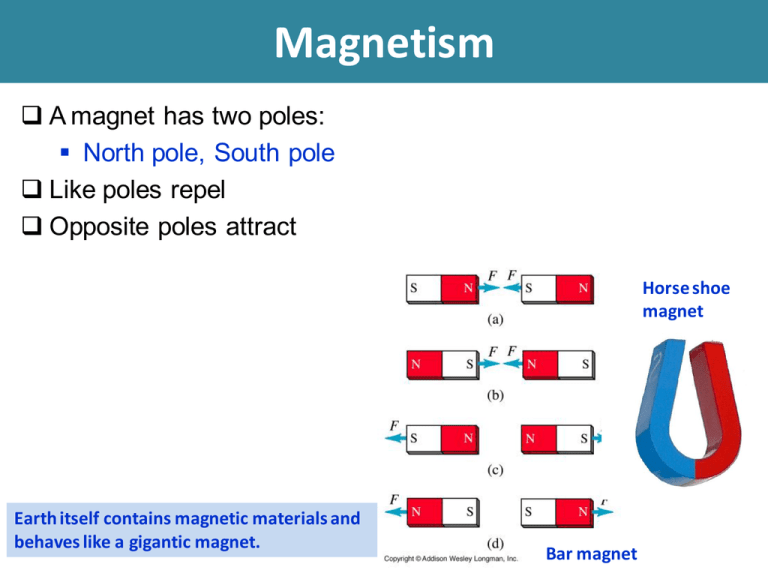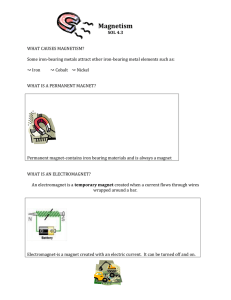Magnetism
advertisement

Magnetism A magnet has two poles: North pole, South pole Like poles repel Opposite poles attract Horse shoe magnet Earth itself contains magnetic materials and behaves like a gigantic magnet. Bar magnet Magnetic Field A magnet creates an invisible area of magnetism all around it called a magnetic field. Magnetism Cutting a bar magnet in half is like cutting an earthworm in half! You get two brand new, smaller magnets, each with its own north and south pole. = + = + Magnetism Penetrates Put a bar magnet onto a table and place an iron nail nearby If you push the magnet slowly toward the nail, there will come a point when the nail jumps across and sticks to the magnet Magnets can “act at a distance” Magnetic fields can penetrate through materials, not just air Paper: Little notes stuck to the door of your refrigerator with magnets Iron: Use a magnet to pick up a long chain of paperclips, with each clip magnetizing the next one along. Earth’s Magnetism Earth itself is a GIANT magnet! Because it contains magnetic materials North Pole: Aurora Borealis South Pole: Aurora Australis Other Stars and Planets’ Magnetism What about other stars and planets? Sun has a magnetic field several times stronger than Earth's, but the Moon has no little or no magnetism. Other planets have magnetic fields too Stronger than Earth: Saturn, Jupiter, Neptune, and Uranus Weaker than Earth: Mars, Mercury, and Venus North Pole Aurora Borealis From aero plane Why Magnetism Exists? Domain Theory Atomic Theory Electricity and Magnetism are Just two sides of the same coin! Experiments with Electricity and Magnetism Beakman’s Electric Motor Experiment 3 Beakman’s Electric Motor Explanation Beakman’s Electric Motor: Explanation In the Beakman motor, that black square you see is a magnet. The coil has to be closer to one pole of the magnet (I don't see how it would work if it is right in the middle equidistant from the magnet's poles). So if you use a bar magnet, you have to be closer to one end. The current (from battery connected to wire armature via little hook cradles) goes around the armature windings in a loop (circle). This generates a magnetic field around the wire and turns the loop into a magnet (say N pole on top, S on bottom). If the loop is nearer the S pole of the bar magnet the loop will rotate so the N pole moves toward the bar magnet and the S pole moves away, so the loop turns. However when the loop makes a 1/2 turn, the current is cut off (because the wire has insulation on the side that is now in contact with the cradle contact) but the loop continues its motion (inertia) until the part with no insulation moves into contact and the current flows again repeating the cycle. In a normal DC motor, at the 1/2 turn the current switches direction (using a commutator) flipping the N and S poles of the loop instead of shutting off the magnetic poles, so there is positive torque at all times instead of torque on only half of the cycle.




